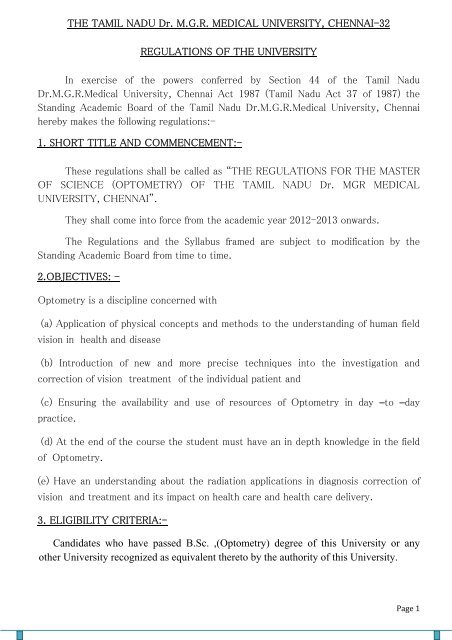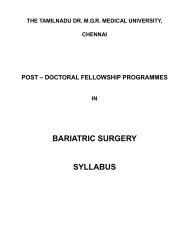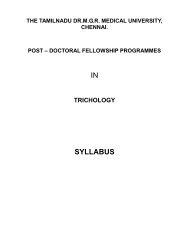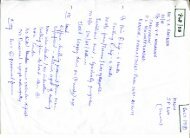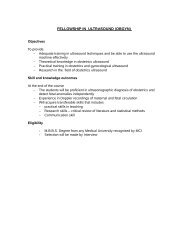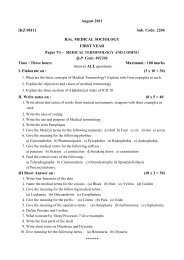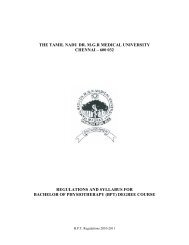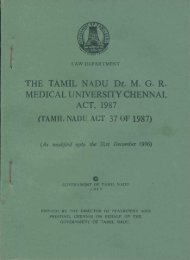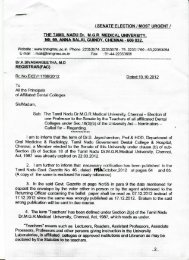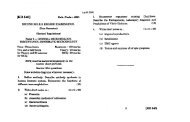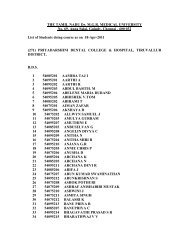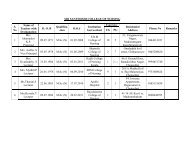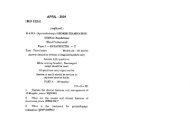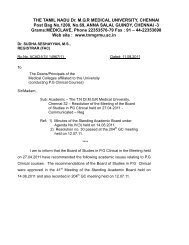M.Sc. (Optometry) Syllabus & Regulations - Tamil Nadu Dr. MGR ...
M.Sc. (Optometry) Syllabus & Regulations - Tamil Nadu Dr. MGR ...
M.Sc. (Optometry) Syllabus & Regulations - Tamil Nadu Dr. MGR ...
You also want an ePaper? Increase the reach of your titles
YUMPU automatically turns print PDFs into web optimized ePapers that Google loves.
THE TAMIL NADU <strong>Dr</strong>. M.G.R. MEDICAL UNIVERSITY, CHENNAI-32<br />
REGULATIONS OF THE UNIVERSITY<br />
In exercise of the powers conferred by Section 44 of the <strong>Tamil</strong> <strong>Nadu</strong><br />
<strong>Dr</strong>.M.G.R.Medical University, Chennai Act 1987 (<strong>Tamil</strong> <strong>Nadu</strong> Act 37 of 1987) the<br />
Standing Academic Board of the <strong>Tamil</strong> <strong>Nadu</strong> <strong>Dr</strong>.M.G.R.Medical University, Chennai<br />
hereby makes the following regulations:-<br />
1. SHORT TITLE AND COMMENCEMENT:-<br />
These regulations shall be called as “THE REGULATIONS FOR THE MASTER<br />
OF SCIENCE (OPTOMETRY) OF THE TAMIL NADU <strong>Dr</strong>. <strong>MGR</strong> MEDICAL<br />
UNIVERSITY, CHENNAI”.<br />
They shall come into force from the academic year 2012-2013 onwards.<br />
The <strong>Regulations</strong> and the <strong>Syllabus</strong> framed are subject to modification by the<br />
Standing Academic Board from time to time.<br />
2.OBJECTIVES: -<br />
<strong>Optometry</strong> is a discipline concerned with<br />
(a) Application of physical concepts and methods to the understanding of human field<br />
vision in health and disease<br />
(b) Introduction of new and more precise techniques into the investigation and<br />
correction of vision treatment of the individual patient and<br />
(c) Ensuring the availability and use of resources of <strong>Optometry</strong> in day –to –day<br />
practice.<br />
(d) At the end of the course the student must have an in depth knowledge in the field<br />
of <strong>Optometry</strong>.<br />
(e) Have an understanding about the radiation applications in diagnosis correction of<br />
vision and treatment and its impact on health care and health care delivery.<br />
3. ELIGIBILITY CRITERIA:-<br />
Candidates who have passed B.<strong>Sc</strong>. ,(<strong>Optometry</strong>) degree of this University or any<br />
other University recognized as equivalent thereto by the authority of this University.<br />
Page 1
4. ELIGIBILITY CERTIFICATE:<br />
Candidates who have passed any qualifying examination, as specified in<br />
Regulation No.3 above from any other Universities other than the <strong>Tamil</strong> <strong>Nadu</strong> <strong>Dr</strong>.<br />
M.G.R. Medical University before seeking admission to the affiliated institutions shall<br />
obtain an Eligibility Certificate from the University by remitting the prescribed fees<br />
along with the application form which shall be downloaded from the University website<br />
(www.tnmgrmu.ac.in).<br />
5. DURATION OF THE COURSE:- Two years<br />
Each academic year shall consist of not less than 270 working days.<br />
Total No. of days in a year 365 days<br />
No. of weekly off( Sundays) - 52 days<br />
No. of Government Holidays - 22 days<br />
No. of Holidays - 21 days<br />
------------ 95 days<br />
------------<br />
Total No. of working days including 270 days<br />
examination period --------------<br />
6. AGE LIMIT FOR ADMISSION :-<br />
40 years. For SC/ST candidates age relaxation is for 5 years.<br />
7. PHYSICAL FITNESS CERTIFICATE:<br />
Every candidate before admission to the course shall submit to the Director of<br />
the Institution a certificate of medical fitness from an authorized medical officer that<br />
the candidate is physically fit and mentally sound to undergo the academic course and<br />
does not suffer from any disability or contagious disease.<br />
Page 2
8. CUT OFF DATES FOR ADMISSION TO THE COURSE<br />
Candidates admitted up to 31st May/31st October shall be registered to take up<br />
their first year examination from April / October of the next year, after fulfilment of<br />
the regulations.<br />
All kinds of admissions shall be completed on or before 31st May/ 31st October of<br />
the academic year. There shall not be any admissions after 31st May/31st October , even<br />
if seats are vacant.<br />
* It was resolved XXXX111 S.A.B. Dated 19.12.2011.<br />
9. REGISTRATION:<br />
A candidate admitted to the Post Graduate Degree in <strong>Optometry</strong> shall<br />
register his/ her name by submitting the prescribed application form for registration<br />
duly filled in by remitting the prescribed fee to the <strong>Tamil</strong> <strong>Nadu</strong> <strong>Dr</strong>. M.G.R. Medical<br />
University within 30 days from the cut off date prescribed for Post Graduate Degree in<br />
<strong>Optometry</strong>.<br />
10. COMMENCEMENT OF THE COURSE:<br />
1st May/1st October<br />
• It was resolved XXXX111 S.A.B. Dated 19.12.2011.<br />
11. MIGRATION/TRANSFER OF CANDIDATES<br />
Request for Migration/Transfer of candidates during the course of<br />
study from one recognized Institution to another recognized Institution of this<br />
University or from other University shall not be granted under any circumstances.<br />
12. RE-ADMISSION AFTER BREAK OF STUDY<br />
As per the procedure laid down in a common regulation<br />
for all the courses of the <strong>Tamil</strong> <strong>Nadu</strong> <strong>Dr</strong>. M.G.R. Medical University.<br />
13. POSTING AND TRAINING IN OUTSIDE CENTRES:<br />
It is mandatory the M.<strong>Sc</strong>. (<strong>Optometry</strong>) student should undergo fifteen days of<br />
posting in each Speciality Departments like Contact Lenses, Cornea, Paediatric,<br />
Ophthalmology, Glaucoma, Low Vision and Retina (3 months).<br />
Page 3
14. MAINTENANCE OF LOG BOOK:-<br />
a) Every Post Graduate Degree candidate shall maintain a record of skills (Log<br />
Book) he / she has acquired during the two years training period, certified by<br />
the various Heads of Department, where he / she undergone training including<br />
outside the institution.<br />
b) The candidate should also be required to participate in the teaching and training<br />
programme of post-graduate and intern-students.<br />
c) In addition, the Head of the Department shall involve their Post-graduate<br />
Degree course candidates in Seminars, Journal Clubs, Group Discussions and<br />
participation in clinical.<br />
d) Every Post- graduate Degree course candidate should be encouraged to present<br />
short title papers in conferences and improve on it and submit them for<br />
publication in reputed medical journals. Motivation by the Heads of<br />
Departments is essential in this area to sharpen the research skills of the postgraduate<br />
candidates.<br />
e) The Head of the Department shall scrutinize the Log Book once in every three<br />
months.<br />
f) At the end of the course, the candidate should summaries the contents and get<br />
the Log Book certified by the Head of the Department.<br />
g) The Log Book for each years should be submitted 3 months prior to the final<br />
year examinations.<br />
15. DISSERTATION & EVALUATION:-<br />
The topic of the dissertation should be submitted at the end of the first year of the<br />
course. The candidate should also inform the name of the guide for the dissertation to the<br />
University while submitting the dissertations topic.<br />
If there are changes in the dissertation topic, the same has to be informed six<br />
months prior to the final year examination.<br />
The dissertation should be submitted duly signed by the Professor of<br />
Ophthalmology and the same has to be forwarded to the Controller of Examination<br />
through the Head of the Institution two months prior to the Examination.<br />
For dissertation marks 200, Viva-voce on dissertation/Presentation mark 50 and IA<br />
50– Minimum mark to pass 150.<br />
* It was resolved XXXX111 S.A.B. Dated 19.12.2011.<br />
Page 4
If the dissertation is not approved (Failed) by the majority of the examiners, the<br />
results shall be withheld till the resubmitted dissertation is approved (Passed).<br />
If the candidate fails in the Written / Practical Examination, but his / her<br />
dissertation is approved(Passed), the approval of the dissertation shall be carried over<br />
to the subsequent examination.<br />
16. ATTENDANCE REQUIREMENT FOR ADMISSION TO<br />
EXAMINATION<br />
a) No candidate shall be permitted to appear in any one of the parts of M.<strong>Sc</strong>.,<br />
(<strong>Optometry</strong>) Course Examinations, unless he / she has attended the course in all the<br />
subjects for the prescribed period in an affiliated Institution recognized by this<br />
University and has to produce the necessary certificates of study, attendance,<br />
satisfactory conduct and progress from the Head of the Institution.<br />
b) A candidate is required to put in a minimum of 90% of attendance (of 270 days)<br />
each in theory and practical classes in each subject before admission to the<br />
examination.<br />
c) A candidate lacking in the prescribed attendance and progress in any one subject in<br />
theory and practical classes, wherever necessary in the first appearance, shall not be<br />
permitted for admission to the entire examination.<br />
17. CONDONATION OF LACK OF ATTENDANCE:<br />
programme.<br />
There shall be no condonation of lack of attendance in Post Graduate degree<br />
18.COMMENCEMENT OF EXAMINATION:<br />
15th April/15th October<br />
* It was resolved XXXX111 S.A.B. Dated 19.12.2011.<br />
There shall be two University examinations in an academic year. The I Batch<br />
Examinations will commence from 15th April and the II Batch Examinations will<br />
commence from 15 th October. If the date of commencement of the examination falls on<br />
Saturdays, Sundays or declared Public Holidays, the examination shall begin on the<br />
next working day.<br />
Page 5
19. MEDIUM OF INSTRUCTION:<br />
English shall be the medium of instruction for all the subjects<br />
of study and examination of the Post-graduate Degree in <strong>Optometry</strong>.<br />
20. AWARD OF DEGREE :-<br />
The degree shall be awarded by the University only after the<br />
successful completion of the course.<br />
21. AWARD OF MEDALS / PRIZES:-<br />
The University shall award at its Convocation, medals and prizes to<br />
outstanding candidates as and when instituted by the Donors as per the schedule<br />
prescribed for the award.<br />
22. PASSING MINIMUM:<br />
A candidate shall be declared to have passed in each paper/subject if he / she<br />
secures NOT LESS THAN 50% of the marks prescribed for the examinations.<br />
23. RETOTALLING OF ANSWER PAPERS:-<br />
Re-totalling is allowed in the failed subjects. Revaluation is not allowed.<br />
24. NUMBER OF APPEARANCE/COMPLETION OF THE COURSE OF STUDY<br />
The duration for completion of the course is double the duration of the<br />
course i.e. 4 years to pass the examination, from the date of joining the course.<br />
Otherwise he / she has to be discharged from the course.<br />
25. CURRICULUM:- FIRST YEAR:<br />
Paper - I 0ptometry-I<br />
Paper - II <strong>Optometry</strong> in Special Need Group – LVA<br />
Paper - III Orthoptics<br />
Paper - IV Contact Lens-I<br />
Paper - V Optometric Instruments<br />
Paper - VI Ocular Diseases-I<br />
Paper - VII Optometric Investigation<br />
Page 6
SECOND YEAR:<br />
Paper - I <strong>Optometry</strong>-II<br />
Paper - II Evidence based <strong>Optometry</strong><br />
Paper - III Advanced Orthoptics<br />
Paper - IV Ocular Diseases II<br />
Paper - V Contact Lens-II<br />
Paper - VI Community <strong>Optometry</strong><br />
Paper - VII Applied & Clinical <strong>Optometry</strong><br />
Paper - VIII Systemic Diseases and the eye<br />
examination.<br />
Dissertation is to be submitted three months before the final year<br />
26. INTERNAL ASSESSMENT:<br />
The Internal Assessment should consist of the following points for Evaluation:-<br />
INTERNAL ASSESSMENT – SCHEME : 50 MARKS<br />
Theory Practical Log Book<br />
20 marks 20 marks 10 marks<br />
The Internal Assessment of the candidate has to be assessed on the above<br />
points and a report has to be submitted by the institution as detailed below:-<br />
The aggregate of Final Internal Assessment Marks should be submitted 2<br />
months before the commencement of the exam as per scheme of examination shall<br />
be taken by the University as Internal Assessment Marks and minimum of 50%<br />
marks is mandatory for permitting the candidates to sit for the University<br />
examinations.<br />
Page 7
27. SCHEME OF EXAMINATION:<br />
FIRST YEAR<br />
S.No Subjects<br />
Internal<br />
Assessment<br />
(IA)<br />
Theory<br />
Practical<br />
Viva Voice<br />
Max Min Max Min Max Min Max Min<br />
1. 0ptometry-I 50 25 100 50 100 50 - -<br />
2. <strong>Optometry</strong> in Special<br />
Need Group – LVA<br />
50 25 100 50 - - - -<br />
3. Orthoptics 50 25 100 50 100 50 - -<br />
4. Contact Lens-I 50 25 100 50 - - - -<br />
5. Optometric<br />
Instruments<br />
50 25 100 50 100 50 - -<br />
6. Ocular Diseases-I 50 25 100 50 - - - -<br />
7. Optometric<br />
Investigation<br />
50 25 100 50 - - - -<br />
Page 8
S.No Subjects<br />
SECOND YEAR<br />
Internal<br />
Assessment<br />
(IA)<br />
Theory<br />
Practical<br />
Viva Voice<br />
Max Min Max Min Max Min Max Min<br />
1. <strong>Optometry</strong>-II 50 25 100 50 - - - -<br />
2. Evidence based<br />
<strong>Optometry</strong><br />
50 25 100 50 100 50 - -<br />
3. Advanced Orthoptics 50 25 100 50 100 50 - -<br />
4. Ocular Diseases II 50 25 100 50 - - - -<br />
5. Contact Lens-II 50 25 100 50 100 50 - -<br />
6. Community<br />
<strong>Optometry</strong><br />
7. Applied & Clinical<br />
<strong>Optometry</strong><br />
8. Systemic Diseases<br />
and the eye<br />
50 25 100 50 - - - -<br />
50 25 100 50<br />
50 25 100 50<br />
If a candidate fails in practical (or) theory he/she has to write BOTH the practical<br />
paper and the RELATED theory subject.<br />
Evaluation of Dissertation 200<br />
Viva/Presentation 50<br />
IA 50<br />
Total 300<br />
Passing Minimum 150<br />
* It was resolved XXXX111 S.A.B. Dated 19.12.2011.<br />
Page 9
The candidates having arrear papers should complete and pass the first<br />
year papers before appearing for the final year examinations.<br />
28. AUTHORITY TO ISSUE TRANSCRIPT :-<br />
The Controller of Examinations shall be the authority for issuing transcript of<br />
marks after remitting the prescribed fee.<br />
29. SUBMISSION OF PRACTICAL RECORD BOOKS :-<br />
At the time of Practical Examination, each candidate shall submit to the<br />
Examiners his / her Practical Record Books duly certified by the Head of the<br />
Department as a bonafide record of the work done by the candidate.<br />
The concerned Head of the Department shall evaluate the Practical Record<br />
(Internal Assessment) and the Practical Record shall be presented to the Examiner at<br />
the time of examinations at the end of each year.<br />
30. QUESTION PAPER PATTERN:-<br />
Theory<br />
Essay - 2 x 20 Marks = 40 Marks<br />
Short Notes - 10 x 6 Marks = 60 Marks<br />
Requirement for pass: 50% in each paper<br />
-------------<br />
100 Marks<br />
-------------<br />
Page 10
SYLLABUS FOR M.<strong>Sc</strong>. OPTOMETRY COURSE<br />
PAPER I OPTOMETRY I<br />
OPTICS A<br />
1. NATURE OF LIGHT:<br />
FIRST YEAR<br />
a) Wave nature of light – short comings of wave theory.<br />
b) Quantum theory – dual nature of light.<br />
c) Mathematical representation of wave – S.H.M. Energy composition of<br />
S.H.M. in a straight line and at right angles.<br />
d) Huygen’s Principle – Laws of reflection and refraction at spherical<br />
surfaces and lenses.<br />
e) The paraxial region.<br />
f) Ray and wave velocity.<br />
2. INTERFERENCE:<br />
a) Description of the phenomena – Young’s experiments, coherent sources, phase<br />
and path difference, and intensity. Theory of interference fringes.<br />
b) Interference in this films – interference due to reflected and transmitted<br />
light – eye’s single mirror.<br />
c) Colours of thin films – wedge shaped thin films – testing of plainness of<br />
surface.<br />
d) Newton’s rings experiment – refractive index of liquid.<br />
e) Non-reflecting films.<br />
f) Visibility of fringes.<br />
3. DIFFRACTION:<br />
a) Single slit, qualitative and quantitative.<br />
b) Circular aperture<br />
c) Double slit pattern<br />
d) Multiple slit grating<br />
e) Reflection grating and the zone plate.<br />
Page 11
4. POLARISATION:<br />
a) Polarization of tranverese waves – light as transverse waves.<br />
b) Double refraction, principal plans, Nicol prism – plane polarization<br />
c) Circular, elliptic polarization production, detection and behaviour.<br />
d) Optical activity – Fresnel’s half shade polarimeter.<br />
e) Polarisation by selective absorption – dichorism.<br />
f) Basic principles of Holography.<br />
5. SPECTRUM:<br />
a) Sources of spectrum, Bunsen – carbon – mercury - sodium<br />
b) Emission and absorption spectra – classification –visible – ultra violet<br />
and intra red spectra – electromagnetic spectrum.<br />
6. SCATTERING:<br />
a) Rayleigh’s scattering<br />
b) Raman scattering<br />
7. SURFACE TENSION<br />
8. VISCOSITY<br />
Principles of Lighting<br />
1. Visual Tasks – Factors affecting Visual tasks.<br />
2. Modern theory on light and colour synthesis of light<br />
3. Additive and subtractive synthesis of colour<br />
4. Light sources – Modern light sources, spectral energy, distribution,<br />
luminous efficiency, colour temperature, colour rendering<br />
5. Illumination – Luminious flux, candela, solid angle<br />
6. Illumination – Utilization factor, depreciation factor<br />
7. Illumination laws<br />
8. Lighting installation – glare, luminaries, lighting fixtures, types of lighting.<br />
9. Requirements for illuminations of work place<br />
10. Typical lighting installations<br />
11. Specialized aspects of illumination, endoscopes, headlamps etc.<br />
12. Photometry – measurement of illumination, photometers and filters.<br />
13. Eye care and lighting – special case.<br />
Page 12
Text and reference Books:<br />
a) Geometrical, Physical and Visual Optics – Micheale Keating Butterworth<br />
Heinemann.<br />
b) A Textbook of Optics N.SUBRAMANYAM & BRIJLAL<br />
c) Fundamental of Optics : F.A. JENKINS & H.E. WHITE<br />
1. Photometry<br />
OPTICS B<br />
a. Basic concepts and definitions in Photometry.<br />
b. Reflection co-efficient, transmission co-efficient, powers –transmitted<br />
and reflected – Lumen Bodhun photometer.<br />
2. Refraction Through Spherical Surfaces :<br />
a. Introduction – Lens shapes, vergences and conversion factors.<br />
Divergence and secondary focal points – predictable rays.<br />
b. Spherical refracting interfaces – convex, concave, derivation of<br />
vergence equation, sagittas, dioptric power – focal points, nodal points<br />
and plane. Symmetry point imaging examples, lateral magnification.<br />
c. Thin lens equation – lenses in contact separated. Two lens systems –<br />
reduced systems using vergence techniques.<br />
d. Application – calculation of image points, dioptric powers in reduced<br />
systems using vergence techniques.<br />
e. Thick lenses – front and back vertex powers – reduced system –dioptric<br />
power of equivalent lenses, cardinal points. Application to calculate<br />
the equivalent dioptric power of thick meniscus lens. Plano convex,<br />
vertex powers, position of principal planes, dioptric powers using<br />
reduced systems. Matrix theory and lens matrices.<br />
3. Aberrations:<br />
a. Chromatic aberrations – dispersion without deviation and deviation<br />
with dispersion.<br />
b. Dispersion by a prism – angular dispersion – dispersion power –<br />
dispersion without deviation and deviation without dispersion.<br />
Achromatic prims and lenses – prism diopters.<br />
Page 13
c. Monochromatic aberrations – first order and third order theory.<br />
d. Spherical aberrations, coma, astigmatism, curvature, distortion – cause<br />
and the methods of minimizing aberrations.<br />
e. Tangent condition for elimination of distortion<br />
4. Fiber optics – Introduction and uses, general applications in Ophthalmic &<br />
Optical industry.<br />
5. Colour theories – trichromatic colour measurement.<br />
6. Optical instruments – spectrometer – simple and compound microscope –<br />
telescope. Fresnel’s biprism – Resolving power of optical instruments –<br />
Dispersion power – magnifying power of simple and compound<br />
microscope, t telescope.<br />
7. Applications of vergence technique to calculate dioptric powers,<br />
separation distances in microscopes and telescopes.<br />
Geometrical Optics Lectures by Physics faculty<br />
1. Rectilinear propagation, Shadows, Huygen’s principle.<br />
2. Reflection at plane mirrors, Multiple reflections.<br />
3. Refraction, refractive index, velocity of light.<br />
4. Vergence – Power of single surface. Ray tracing.<br />
5. Thin lens image formation Conjugate foci.<br />
6. Lens aberrations – general<br />
7. Lens aberrations – correction<br />
8. Astigmatic pencils<br />
9. Chromatic aberrations of lenses and its correction.<br />
10. Total internal reflection prism deviation.<br />
11.Minimum and maximum deviation – achromatic prisms.<br />
12.Spherical, Cylindrical and toric surfaces.<br />
13.Aspheric surfaces and lenses.<br />
14.Coaxial systems of spherical surfaces. Reduced vergence<br />
15.Coaxial systems of thin lenses.<br />
16.Stops and apertures in lens systems.<br />
17. Thick lenses and lens systems<br />
18. Thick lenses – advances<br />
Page 14
19.Dispersion Spectra<br />
20.Magnification and magnifiers.<br />
21.Microscopes introductory<br />
22.Microscopes design<br />
23. Telescopes – History and principles<br />
24. Telescopes – Design and uses<br />
25.Holograms<br />
Text and reference Books<br />
a. Geometrical, Physical and Visual Optics – Micheale Keating Butterworth<br />
Heinemann<br />
b. A Text Book of Optics : N. Subramaniam & Brij Lal<br />
c. Fundamentals of Optics : F.A. Jenkins & H. E. White<br />
d. Physics for Ophthalmologist – Douglas J.Coster<br />
OPTICS C<br />
Ophthalmic Lenses Theory Basics (i)<br />
1. Introduction – Light, mirror, reflection, refraction & absorption.<br />
2. Definitions – Prisms, lenses, frames, spectacles.<br />
3. Prisms – definition, properties, refraction through prisms units.<br />
4. Prisms – uses of prisms. Nomenclature prisms.<br />
5. Thickness difference and base – apex notation.<br />
6. Sign Conventions.<br />
7. Lenses – Definition, Terminology used to describe lenses.<br />
8. Form of Lenses – Convex lenses & concave lenses<br />
9. Refraction & image formation through convex and concave lenses.<br />
10.Determination of focal length and dioptric power of iris.<br />
11.Surface power and radius, refractive index values.<br />
12.Vertex distance and vertex power.<br />
13.Effectivity and effective powers.<br />
14.Lens shape, size, Types i.e. Spherical, Cylindrical, Sphero cylindrical<br />
15. Toric surfaces and their significance, Toric lenses<br />
16.Sturm’s conoid.<br />
Page 15
17.Neutralization of lenses<br />
18.Spherometer and sag formula<br />
19.Focimeter – power of lens and prisms<br />
20.Center marking & Axis marking by focimeter.<br />
21.Simple Transposition.<br />
22. Toric transposition.<br />
23.Prismatic effect, Centeration. Decentration, Prentice’s rule.<br />
24.Prismatic effect of sphero-cylinders and Plano cylinders.<br />
25.Differential prismatic effects.<br />
26.Decentration of lenses and edge thickness.<br />
27.Decentration examples.<br />
28.Components and interpretation of spectacles prescription.<br />
29.Prescription mistakes commonly made.<br />
30.Prismatic effect of sphero-cylindrical lenses.<br />
31.Aberrations in Opthalmic lenses<br />
32. Tilt induced power in spectacles lenses<br />
33.Magnification in high plus lenses<br />
34.Minification in high minus lenses<br />
Ophthalmic Lenses Types, Manufacturing, Workshop Practice<br />
1. Prescription laboratory in action.<br />
2. Instruments for making lenses<br />
3. Outline of lens surfacing and polishing<br />
4. Recording and ordering of Ophthalmic lenses<br />
5. Terminology used in Lens workshops<br />
6. Ophthalmic raw material – history and general outline.<br />
7. Manufacturing of Ophthalmic blanks – Glass<br />
8. Glass lenses – material types and characteristics<br />
9. Glass working –spherical surfaces<br />
10.Glass working – Toric and Aspeherical<br />
11.ISI Standards for lenses<br />
12.Ophthalmic lens designs – best form lenses<br />
13.Design of high powered lenses<br />
Page 16
14.Bifocal design and manufacture<br />
15.Faults in lenses – description<br />
16.Faults in lenses – detection<br />
Spectacles Frames – theory basics (1)<br />
1. History of spectacles<br />
2. Nomenclature and terminology<br />
3. Types and Parts of spectacle frames<br />
4. Spectacles frames – sides and joints<br />
5. Spectacle frame bridge<br />
6. Shapes of spectacle frames – advantages and disadvantages<br />
7. Spectacle frame measurements and markings.<br />
Text and reference Books<br />
a) Spectacle Lenses – Theory and practice – Coling Fowler, Butterworth<br />
Heinemann.<br />
b) Ophthalmic Lenses and dispensing – M.Jalie, Butterworth Heinemann.<br />
c) Spectacles Lenses – Theory & Practice – Colin Fowler, Keziah Latham<br />
d) Ophthalmic Lenses and Dispensing – M.Jalie<br />
PAPER – II OPTOMETRY IN SPECIAL NEED<br />
GROUP – LVA<br />
Unit-I<br />
1. a. Correction of spherical ametropia<br />
b. Axial versus refractive ametropia<br />
c. Ocular refraction versus spectacle refraction<br />
d. Ocular accommodation versus spectacle accommodation<br />
e. Rational image blur, depth of focus and depth of field.<br />
2. Measurement of the optical constants of the eye<br />
a. Corneal curvature and thickness<br />
b. Keratometry<br />
c. Curvature of the lens and ophthalmic phakometry<br />
d. Axial and axis of the eye<br />
e. Far and Near Point of Accommodation<br />
Page 17
f. Subjective Methods of refractions<br />
g. Objective Methods of refraction<br />
h. Guideline for correction of refractive error<br />
i. Patient Management<br />
Unit-II<br />
Optics Practical Demonstrations<br />
1. Visual acuity, stereo acuity in emmetropia<br />
2. Myopia and pseudomyopia, myopia and visual acuity<br />
3. Myopic correction-subjective verification and monocular and binocular<br />
4. Hypermetropia – determination of manifest error subjectively<br />
5. Hypermetropio correction – subjective verification<br />
6. Demonstration of astigmatism: Use of slit and keratometry to find the<br />
principal meridians<br />
7. Astigmatism: Fan – subjective verification tests.<br />
8. Astigmatism: Cross-cyl. Subjective verification tests.<br />
9. Measurement of accommodation: near and far points and range<br />
10.Presbyopic correction and methods: accommodative reserve, balancing<br />
the relative accommodation and cross grid cylinder test.<br />
11.Methods of differentiating axial and refractive ametropia<br />
12.Practice of Retinoscopy – Emmetropia<br />
13.Practice of Retinoscopy - spherical ametropia<br />
14.Practice of Retinoscopy – simple astigmatism<br />
15.Practice of Retinoscopy – compound hyperopia.<br />
Unit-III: Low Vision Aids<br />
1. Identifying a low vision patient<br />
2. History<br />
3. Refraction<br />
4. Evaluation of near vision Amsler grid and the field defects<br />
5. Demonstrating aids<br />
6. Teaching the patient to use aids<br />
7. Guide to selected low vision aids<br />
8. Fitting spectacles telescope and glasses<br />
Page 18
9. Children with low vision<br />
10.Effects of the eye condition of functional vision<br />
11.Light, glare and contrast in low vision care rehabilitation<br />
12.Diagnostic procedures in low vision care management<br />
13.Optics of low vision aids<br />
14.Bioptic telescopes<br />
15.Optical devices that help people with field defects<br />
Text Book & Reference Books<br />
a. Practice of Refraction – Duke Elders, Edn. 9, 1991<br />
b. Optics & Refraction – A.K. Khurana<br />
c. Clinical Optics – Budd Appleton<br />
d. Low Vision Aids – Monika Chaudhry<br />
PAPER – III - ORTHOPTICS<br />
Investigation of Normal Binocular Function and Vision<br />
1. History & Observation<br />
2. Cover Test & Assessment of Ocular Motility to include all systems<br />
3. Assessment of Vision: Methodology; Selection of tests; Modification of Testing<br />
in relation to Amblyopia; Investigation of non-organic Vision Loss<br />
4. Accommodation / Convergence: Types of Convergence; Accommodative Lead &<br />
Lag; Relative Convergence & Accommodation; AC/A & CA/C Ratios;<br />
Classification of Convergence & Accommodation Anomalies; Management of<br />
Convergence & Accommodation Anomalies; Relevance to Strabismus<br />
5. Assessment of Fusion: Motor Fusion; Relative Fusional Vergences;<br />
Methodology; Normative Values; Significance of Defective Fusion<br />
6. Assessment of Stereopsis: Types of Stereotests; Application to Age Group &<br />
Quality of BSV<br />
Amblyopia<br />
1. Development<br />
2. Classification<br />
3. Investigation<br />
4. Factors influencing prognosis<br />
5. Optical, Pharmacological & Orthoptic Management<br />
Page 19
Concomitant Strabismus<br />
Heterophoria<br />
1. Associated / dissociated Heterophoria<br />
2. Classification<br />
3. Investigation<br />
4. Indications for Treatment<br />
5. Optical, Orthoptic & Surgical Management<br />
Heterotropia<br />
1. Classification of Esotropia: Microtropia; Infantile (to include DVD) Nystagmus<br />
Blockage Syndrome; Acquired Constant Esotropia; Intermittent Esotropia:<br />
Near; Distance & Non-specific; Accommodative Esotropia: Fully<br />
Accommodative; Convergence Excess; Partially Accommodative Esotropia;<br />
Cyclic Esotropia; Secondary Esotropia; Consecutive Esotropia<br />
2. Classification of Exotropia: Infantile Exotropia; Constant Acquired Exotropia;<br />
Intermittent Exotropia: Near; Distance; Secondary Exotropia; Consecutive<br />
Exotropia; Associated Vertical Deviations<br />
3. Clinical Characteristics & Differential Diagnoses of Esotropias & Exotropias<br />
4. Assessment of Binocular Function in Heterotropia and Significance of Findings<br />
5. Associated Alphabetical Patterns and Influence on Findings<br />
6. Optical, Orthoptic & Surgical Management of Heterotropia, including Timing of<br />
Intervention<br />
Infranuclear Deviations<br />
1. Functions of EOM: Primary,Secondary & Tertiary actions; OM systems<br />
2. Examination of EOM function & systems; Examination of versions / ductions;<br />
Hess / Lees screens; Field of BSV; Field of Uniocular Fixation<br />
3. Muscle sequelae; Differential Diagnosis of Neurogenic / Mechanical Palsies<br />
Neurogenic Palsies<br />
1. Aetiology of Cranial Nerve Palsies<br />
2. Diagnosis & Characteristics of IIIN Palsy; Partial / Complete IIIN palsy;<br />
Differential Diagnosis of Congenital/ Acquired IIIN Palsy; Misdirection<br />
Syndrome; Management of IIIN Palsy<br />
3. Characteristics & Diagnosis of IVN Palsy; Differential Diagnosis of Congenital /<br />
Acquired IVN Palsy; Bielschowsky Head Tilting Test; Park’s Three Step Test;<br />
Management of IVN Palsy<br />
4. Characteristics & Diagnosis of VIN Palsy; Differential Diagnosis Congenital /<br />
Acquired VIN Palsy; Differential Diagnosis of Congenital VIN Palsy & Duane’s<br />
Retraction Syndrome; Management of VIN Palsy<br />
Page 20
Mechanical Palsies<br />
1. Aetiology, Clinical Characteristics & Diagnosis of Duane’s Retraction Syndrome<br />
2. Aetiology, Clinical Characteristics & Diagnosis of Brown’s Syndrome<br />
3. Aetiology, Clinical Characteristics & Diagnosis of General Fibrosis Syndrome;<br />
Strabismus Fixus; Adherence Syndrome<br />
4. Aetiology, Clinical Characteristics & Diagnosis of Blow-out Fractures<br />
5. Aetiology, Clinical Characteristics & Diagnosis of Thyroid Eye Disease<br />
6. Management of Mechanical Deviations<br />
Internuclear Palsy<br />
1. Aetiology, Clinical Characteristics & Diagnosis of Internuclear Palsies;<br />
Unilateral / Bilateral INO;<br />
2. Management of INO<br />
Supranuclear Palsy<br />
1. Aetiology, Clinical Characteristics & Diagnosis of Supranuclear Palsies;<br />
2. Management of Supranuclear Palsies<br />
Nystagmus<br />
1. Classification<br />
2. Investigation;<br />
3. Significance in Strabismus; Significance in Assessment of VA & Refraction<br />
4. Management of Nystagmus<br />
Anomalies of Binocular Vision in Congenital Syndromes<br />
To include: Marcus Gunn Jaw-Winking phenomenon; Down’s Syndrome; Cerebral<br />
Palsy; Craniofacial Anomalies<br />
Reference Books:<br />
1. Pediartirc ophthalmology & Strabismus, Basic & Clinical <strong>Sc</strong>ience course,<br />
American Academy of Opthalmology<br />
2. Pediartic Ophthalmology & Strabismus, Kenneth. W. Wright, Mosby Publishers,<br />
St. Louis,MO 63146<br />
3. Pediatric Optimetry, Jerome Rosner, Butterworth Publishers, Houston, Texas.<br />
4. Clinical Management of Binocular Vision: Heterophoric, Accommodative and Eye<br />
movement disorders, Mitchell <strong>Sc</strong>heiman & Bruce Wick, Lippincott Wiliams &<br />
Winkins.<br />
5. Diagnosis and Management of Ocular Motility Disorders<br />
Ansons and Davis. 3 rd Edition. (Blackwell <strong>Sc</strong>ience)<br />
6. Clinical Orthoptics. Fiona Rowe. 2 nd Edition. (Blackwell <strong>Sc</strong>ience)<br />
Page 21
7. Binocular Vision and Ocular Motility. Theory and Management of Strabismus.<br />
G.K. Von Noorden and E.C. Campos. 6 th Edition. (Mosby)<br />
8. The Neuro-Ophthalmology Survival Guide. Anthony Pane, Michael Burdon and<br />
Neil R Miller. Mosby Elsevier.<br />
PAPER – IV - CONTACT LENS I<br />
Unit-I<br />
1. History of Contact lenses<br />
2. Related ocular anatomy and physiology<br />
3. Related Visual Optics<br />
4. Contact Lens materials, terminology, classification<br />
5. Optics of contact Lenses, comparison spectacles<br />
6. Indications and contraindications<br />
7. Advantages and disadvantages of types of Contact lenses<br />
8. Manufacturing Rigid and Soft Contact lenses – various methods<br />
9. Pre-Fitting examination – steps, significance, recording of results<br />
10.Instruments used for examination<br />
11.Special Investigations in pre-fitting examinations<br />
12.Keratometry and Cornea; topography<br />
13.Slit Lamp examination<br />
14.Discussion with patient, choice of lens type<br />
Unit-II<br />
1. Fitting philosophies of contact Lenses – general outline<br />
2. Fitting Rigid Contact lenses<br />
3. Using trial lenses – calculations involved<br />
4. Methods of assessment of Contact Lens fit.<br />
5. Types of fit – Steep, Flat, Optimum – on spherical cornea.<br />
6. Types of fit – Steep, Flat, Optimum – on Toric cornea with spherical lenses<br />
7. Types of fit – Steep, Flat, Optimum – on Toric cornea with toric lenses<br />
Page 22
Unit-III<br />
1. Calculation and finalizing of Contact Lens parameters<br />
2. Ordering Rigid verifying Contact Lens – writing a prescription to the<br />
Laboratory.<br />
3. Checking and verifying Contact Lens from Laboratory<br />
4. Modifications possible with Rigid lenses<br />
5. Components of Lens Care systems for Rigid lenses<br />
6. Contact lens solutions- composition necessity advantages.<br />
7. Teaching the patient to insert and remove Rigid lenses.<br />
8. Common handling instructions to first time wearers<br />
9. Special instructions to the patient wearing Rigid Gas Permeable Contact<br />
Lenses.<br />
Text and reference books<br />
a. Contact Lenses – <strong>Dr</strong>. V.K. Dada<br />
b. Contact Lenses Practice – MONTAGUE RUBEN<br />
PAPER – V - OPTOMETRIC INSTRUMENTS<br />
Lecture Topics<br />
Unit-I<br />
1. Binocular Vision<br />
Unit-II<br />
1. Refractive Instruments<br />
a. Test charts standards<br />
b. Choice of test charts<br />
c. Trial case lenses<br />
d. Refractor (phoropter) head units<br />
e. Optical considerations of refractor units<br />
f. Trial frame design<br />
g. Near vision difficulties with units and trial frames<br />
h. Retinoscope – types available<br />
i. Adjustment of Retinoscope – special features<br />
j. Cylinder retinoscopy<br />
Page 23
k. Objective optopmeters<br />
l. Coincidence optometers-principals and details<br />
m. Infrared optometer devices<br />
n. The interpretation of objective findings<br />
o. Speacial subjective test polarizing and displacement etc.<br />
p. Projection charts<br />
q. Illumination of the consulting room<br />
r. Time and motion study in refraction<br />
s. Furniture and accessories in the practice<br />
t. Instruments of the future<br />
Unit-III<br />
1. Ophthalmoscopes and related devices<br />
a. Design of ophthamoscopes- illumination<br />
b. Design of ophthamoscopes- viewing<br />
c. Ophthamoscopes disc<br />
d. Filters for ophthamoscopes<br />
e. Indirect ophthamoscopes<br />
f. The use of ophthamoscopes in special cases.<br />
2. Lensometer, lens gauge or clock<br />
Unit-IV<br />
1. Slit Lamp<br />
a. Slit lamp systems<br />
b. Viewing microscope systems<br />
c. Slit lamps in production<br />
d. Slit lamp accessories<br />
e. Slit lamp techniques<br />
f. Slit lamp appearances<br />
g. Mechanical design instruments<br />
2. Tonometer<br />
a. Tonometer principles<br />
b. Types of tonometers and standardization<br />
c. Use and interpretation of tonometers<br />
Page 24
3. Fundus Camera<br />
a. The fundus camera - principles<br />
b. The fundus camera – techniques<br />
4. External eye photography - apparatus.<br />
a. External eye photography - techniques<br />
5. Corneal examination<br />
a. Placidos Disc.<br />
b. Keratometer<br />
c. Video Keratoscopy<br />
d. Corneal Topography<br />
e. Specular Microscope<br />
f. Aesthesiometer<br />
g.Pachymetry<br />
6. Exopthalmometer<br />
7. Refractionometer<br />
8. Orthoptic Instruments<br />
a. Orthoptic instruments - haploscopes<br />
b. Orthoptic instruments – home devices<br />
c. Orthoptic instruments – pleoptics<br />
d. Historical instruments<br />
Unit-V<br />
1. Colour vision testing devices<br />
2. Field of vision and screening devices.<br />
a. Perimeter and visual field<br />
b. Campimeters and fixation devices<br />
c. Illumination of field testing instruments<br />
d. Projection perimeters and Campimeters<br />
e. e <strong>Sc</strong>reening devices for field defects<br />
f. Results of field examination<br />
g. Vision screeners – principles<br />
h. Vision screeners – details<br />
i. Analysis of screener results<br />
Page 25
3. OCT<br />
Text and reference Books<br />
a. Basic Ophthalmology - Renu Jogi 3rd<br />
Ed., Jaypee published<br />
b. Parson’s Diseases of the eye – Ramanjit Sihota. Radhika Tandon 20th<br />
Ed. Elsvier Pvt. Ltd.<br />
c. Low Vision Aids – Monica Chaudhry 2006 Jaypee published<br />
d. Practical Manual of Ophthalmology – Vinod Lohiya 2006, Jaypee<br />
published<br />
e. Basic Ophthalmology – Basak<br />
PAPER – VI - OCULAR DISEASES – I<br />
Lecture Topics<br />
Unit-I: Eyelids<br />
1. Eyelid anatomy<br />
2. Congenital and developmental anomalies<br />
3. Blepharospasm<br />
4. Ectropion<br />
5. Entropion<br />
6. Trichiasis and symblepharon<br />
7. Eyelid inflammations<br />
8. Eyelid tumors<br />
9. Ptosis<br />
10.Eyelid retraction<br />
11.Eyelid trauma<br />
Lacrimal System<br />
1. Lacrimal anatomy<br />
2. Lacrimal pump<br />
3. Methods of lacrimal evaluation<br />
4. Congenital and development anomalies of the lacrimal system<br />
5. Lacrimal obstruction<br />
Page 26
6. Lacrimal sac tumors<br />
1. Lacrimal trauma<br />
Unit-II: <strong>Sc</strong>lera, Episclera<br />
1. Ectasis and staphyloma<br />
2. <strong>Sc</strong>leritis and episcleritis<br />
Orbit<br />
1. Orbital anatomy<br />
2. Incidence of orbital abnormalities<br />
3. Methods of orbital examination<br />
4. Congenital and developmental anomalies of the orbit<br />
5. Orbital tumors<br />
6. Orbital inflammation<br />
7. Sinus disorders affecting the orbit<br />
8. Orbital trauma<br />
Unit-III: Conjunctiva and Cornea<br />
a. Inflammation<br />
b. 1. Therapeutic principles,<br />
2. Specific inflammatory diseases<br />
c. Tumors<br />
1. Tumors of epithelial orgin<br />
2. Glandular and adenexa tumors<br />
3. Tumors of neuroectodermal origin<br />
4. Vascular Tumors<br />
5. Xanthomatous origin<br />
6. Inflammatory tumors<br />
7. Metastatic lesions<br />
d. Degeneration and dystrophies<br />
1. Definition<br />
2. Degeneration’s<br />
3. Dystrophies<br />
Page 27
e. Miscellaneous conditions<br />
1. Keratoconjunctivitis Sicca (K-Sicca)<br />
2. Tear function tests<br />
3. Steven Johnson syndrome<br />
4. Ocular Rosacea<br />
5. Atopic eye disorders<br />
6. Benign mucosal pemphigoid (BMP)-ocular pemhigold<br />
7. Vitamin A deficiency<br />
8. Metabolic diseases associated with corneal changes<br />
Unit-IV: IRIS, Ciliary Body and Pupil<br />
a. Congenital anomalies<br />
b. Primary and secondary disease of the iris and ciliary body<br />
c. Tumors<br />
d. Anomalies of pupillary reaction<br />
Choroid<br />
a. Congenital anomalies of the choroid<br />
b. Diseases of the choroid<br />
c. Tumors<br />
Text and reference books<br />
a. Parsons Diseases of the eye,Ramanjit Sihota, Radhika Tondon. 20th Ed.<br />
Elsevier. Pvt. Ltd.<br />
b. Clinical Ophthalmology – JACK J. KANSKI, 2nd<br />
Ed., 1989 Butterworths.<br />
c. Modern Ophthlmology – L.C.Dutta 3rd<br />
Ed., Jaypee publishers.<br />
d. Ophthalmology for undergraduate strudents – M.L Agrawal, L.C. Gupta,<br />
Sanjeev Agarval - Jaypee published 1st Ed.<br />
e. Text book of ophthalmology – H.V. Nema 4th<br />
Ed., Jaypee publishers.<br />
f. Basic Ophthalogy – Renu Jogi Jaypee publishers.<br />
Page 28
PAPER – VII - OPTOMETRIC INVESTIGATIONS<br />
Lecture Topics<br />
Unit-I<br />
1. Visual Acuity Testing & Theory<br />
2. Colour Vision Testing & Theory<br />
3. Electro Retino Graphy, E.R.G.<br />
4. Electro Oculo Graphy, E.O.G.<br />
5. Electro Myo Graphy, E.M.G.<br />
6. Electro Nystagmo Graphy, E.N.G.<br />
Unit-II<br />
1. Fluorescein Angiography F.A.<br />
2. Ultrasono Graphy U.S.G.<br />
3. Visual Evoked Response / Potential V.E.R. or V.E.P.<br />
4. Tonometer, Tonometry & Tonography<br />
5. Visual Field Charting & Perimetry<br />
6. Adaptation & Adaptometry<br />
7. Berman’s Locator<br />
Unit-III<br />
1. Cryo Technique<br />
2. Diathermy<br />
3. Photo-coagulation<br />
4. Method’s of examination (Focal illumination)<br />
5. Slit lamp and attachments<br />
6. Goinoscopy<br />
7. Pachymetry<br />
8. Ocular Photography (Ant.Seg.)<br />
9. Contact & Trans-illumination<br />
Unit-IV<br />
1. pH Testing & <strong>Sc</strong>hirmer’s Test<br />
2. Fluorescein Staining & Techniques<br />
3. Syringing & Lacrimal Function Test<br />
4. Ophthalmoloscopy<br />
Page 29
5. Retinoscopy<br />
6. Auto-Refraction<br />
7. Keratometry<br />
8. Ophthalmic Lens Measuring Instruments<br />
Text and reference books<br />
a. Clinical procedures in Primary Eye Care – David Elliott, Butterworth<br />
Heinemann<br />
b. Basic and Clinical <strong>Sc</strong>ience Course, American Academy of Ophthalmology (AAO)<br />
c. Clinical Ophthalmology – JACK J. KANSKI, 2nd Ed. 1989 Butterwosths.<br />
Page 30
PAPER – I - OPTOMETRY-II<br />
OPTICS A<br />
Lecture Topics<br />
SECOND YEAR<br />
1. Introduction Vergence and vergence techniques revised. Lens power,<br />
prism power, and cylindrical lenses.<br />
2. Gullstrand’s schematic eyes, visual acuity, Stile Crawford experiment and<br />
binocular telescopes.<br />
3. Emmetropia and ametropia<br />
4. Correction of spherical ammetropia.<br />
5. Thin lens model of the eye – angular magnification – magnification of<br />
microscope telescope, spectacle and relative spectacle magnification.<br />
6. Applications- to calculate the angular magnification, dioptric power of<br />
the spectacles, spectacles magnification, entrance and exit pupils, vertex<br />
distances.<br />
7. Presbyopia.<br />
8. Aphakia<br />
9. Astigmatism – Applications – for e.g. To calculate the dioptoric power,<br />
angular magnification of spectacles in aphakic, presbyopic patients. To<br />
calculate the position of the line image in a sphere cylindrical lens.<br />
10. Laser optics- basic laser principles, - spontaneous and emission.<br />
Coherencespatial, temporal, laser pumping, population inversion optical<br />
feedback laser resonator stability condition.Gas lasers, and solid lasers,<br />
Helium-neon laser Argon ion laser-ruby laser. Monocular laser –<br />
carbondioxide, eximer laser. Semi conductor lasers. Lasers in medicine.<br />
11. Holography<br />
12. Spatial distribution of optical information- modulation transfer functions-<br />
Spatial filtering – applications.<br />
Text and reference Books<br />
a. Optics, WHA Fincham, 9th<br />
edition, Butterworths, 1980.<br />
b. Optics of human eye – Smith Etichision.<br />
Page 31
Lecture Topics<br />
OPTICS B<br />
Unit-I: Review of Geometrical Optics<br />
1. Vergence and power<br />
2. Sign convention<br />
3. Spherical refracting surface<br />
4. Spherical mirror; catoptric power<br />
5. Cardinal points<br />
6. Magnification<br />
Unit-II: Optics of Ocular Structure<br />
1. Cornea and aqueous<br />
2. Crystalline lens<br />
3. Vitreous<br />
4. <strong>Sc</strong>hematic and reduced eye<br />
Unit-III<br />
(A) Refractive conditions of eye<br />
1. Emmetropia<br />
2. Myopia<br />
3. Hyperopia<br />
4. Astigmatism<br />
5. Presbyopia<br />
(B) Refractive Anomalies and Their Cause<br />
1. Aetiology of refractive anomalies<br />
2. Contributing variabilities and their ranges<br />
3. Populating distributions of anomalies<br />
4. Optical component measurements<br />
5. Growth of the eye in relation to refractive errors<br />
Unit-IV: Accommodation and Convergence<br />
1. Far and Near point of accommodation, range of accommodation<br />
amplitude<br />
2. Methods of measurement of Accommodation<br />
3. Near point of convergence of significance<br />
Page 32
4. Methods of measurements of Convergence<br />
5. Accommodative Convergence Accommodation ratio<br />
Unit-V: Retinoscopy – Principles and Methods<br />
1. Retinoscopy – speed of reflex and optimum condition<br />
2. Retinoscopy – design consideration<br />
3. Review of objective refractive methods<br />
4. Review of subjective refractive methods<br />
5. Cross cylinder methods for astigmatism<br />
6. Difficulties in subjective tests and their avoidance<br />
7. Transposition of lenses<br />
8. Spherical equivalent.<br />
Practical Demonstrations<br />
1. Visual acuity, stereo acutiy in emmetropia<br />
2. Myopia and pseudomyopia, myopia and visual acuity<br />
3. Measurement of accommodation: near and far points and range<br />
4. Measurement of Convergence – near point and adduction and abduction range<br />
5. Practice of retinoscopy – Emmetropia<br />
6. Practice of retinoscopy - spherical ametropia<br />
7. Practice of retinoscopy – simple astigmatism<br />
8. Practice of retinoscopy – compound hyperopia<br />
9. Practice of retinoscopy – compound myopia<br />
10. Practice of retinoscopy – oblique astigmatism<br />
11. Practice of retinoscopy – media opacities<br />
12. Practice of retinoscopy – in irregular astigmatism<br />
13. Interpretation of cycloplegic retinoscopic findings<br />
Text and reference books<br />
a. Optics and Refraction – L.P.Aggarwal<br />
b. Principles of Optics and Refraction – Duke Elder<br />
c. Optics & Refraction – A.K. Khuara<br />
d. Visual Optics and Refraction – A clinical approach DAVID D.MICHAELS.<br />
The C.V.Mosby & Co. 1985.<br />
e. Principal & Practice of Refraction – N.C.Singhal<br />
Page 33
PAPER – II - EVIDENCE BASED OPTOMETRY<br />
Lecture Topics<br />
Unit-I: Ophthalmic Lenses Types, Manufacturing, Workshop Practice<br />
1. Recording and ordering of Ophthalmic lenses<br />
2. Terminology used in lens workshop<br />
3. Ophthalmic raw materials – history and general outline<br />
4. ISI Standards for lenses<br />
5. Manufacturing of Ophthalmic blanks – Plastics<br />
6. Plastic lenses – materials types and characteristics<br />
7. Plastic lenses – manufacture<br />
8. Ophthalmic lens designs – best form lenses<br />
9. Design of high powered lenses<br />
10.Bifocal design and manufacture<br />
11.Unusual Lens forms<br />
12.Faults in lenses – description<br />
13.Faults in lenses – detection<br />
Unit-II: Types of Ophthalmic lenses<br />
1. Aspheric lenses<br />
2. High index lenses<br />
3. Bifocal and multifocal lenses – types and characteristics.<br />
4. Bifocal and multifocal lenses - purposes and choice<br />
5. Photo chromic lenses<br />
6. Polaroid lenses<br />
7. Tinted lenses – absorptive properties<br />
8. Tinted lenses – examples and discussions<br />
9. Special purpose lenses<br />
Unit-III: Spectacle Frames – theory basics (I)<br />
1. History of spectacles<br />
2. Nomenclature and terminology<br />
3. Classification of frames – Temple position, colouration<br />
4. Types of frame materials – advantages and disadvantages<br />
Page 34
5. Frame materials – Gold<br />
6. Frame materials – Basic metal<br />
7. Frame materials – Plastics<br />
8. Manufacturing of spectacle frames – overview<br />
9. Face and frame measurement<br />
10.Dyes and colorants – lenses and frames<br />
Unit-IV: Spectacle manufacturing – Optician shops (II)<br />
1. Dispensing counter organization<br />
2. Types of spectacle frames available<br />
3. Types of human faces<br />
4. Face and frame measurements<br />
5. Choice of frames<br />
6. Cosmetic dispensing – different types of faces colours etc.<br />
7. Functional dispensing – various professions and age groups<br />
8. Special purpose frames and accessories<br />
9. Testing of frames – general<br />
10. Testing of frames – special<br />
11. Recording and ordering of frames and appropriate lenses<br />
12. Measurement for ordering spectacles – IPD, marking center, vertex<br />
distance calculations.<br />
13. Special measurements for fitting special lenses – Bifocals, multifocals, prism<br />
lenses etc.<br />
14. Fitting of lenses in various types of frames.<br />
15. Glazing and Edging Processes<br />
16. Glazing of Bifocals, high powered, other special lenses.<br />
17. Faults in lenses – description and detection<br />
18. Final checking, adjustments to prescription spectacles<br />
19. Final dispensing of spectacles to customer<br />
20. Patient complaints, handing and correction<br />
21. Repairs to spectacles – Soldering, rivets for metal plastics frames<br />
22. Special types of spectacles and appliances<br />
23. Monocells and Ptosis crutches<br />
Page 35
Text and reference books<br />
a. Principles of Ophthalmic Lenses : M.JALIE<br />
b. Spectacle Lenses: Theory & Practice – Colin Fowler & Keziah Latham<br />
c. Ophthalmic Lenses and Dispensing – M Jalie<br />
OPTICS & REFRACTION<br />
Lecture Topics<br />
1. a. Tinted and protective lenses<br />
b. Characteristics of tinted lenses<br />
c. Absorptive glasses<br />
d. Polarizing filters<br />
e. Photochromaic filters<br />
f. Reflecting filters<br />
2. Bifocal lenses<br />
3. Trifocal lenses<br />
4. Progressive addition lenses<br />
5. Lenticular lenses<br />
6. a. Spectacle magnifiers<br />
b. Recumbent prisms and present prims<br />
c. Reflections from spectacle lenses, ghost images reflection in bifocals at<br />
the dividing line.<br />
d. Anti-reflection coating<br />
e. Field of the view of the lenses.<br />
f. Size, shape and mountings of the ophthalmic lenses<br />
7. Effective power of spectacles, vertex distance effects<br />
8. Spectacle magnification and relative spectacle magnification<br />
Text and reference books<br />
a. Principle of Ophthalmic Dispensing : M.JALIE<br />
b. Spectacle Lens Theory & Practice – COLIN FOWLER<br />
Page 36
PAPER – III - ADVANCED ORTHOPTICS<br />
Lecturer Topics<br />
Unit-I<br />
Orthoptic check up and special instruments<br />
a. Routine Orthoptic examination<br />
b. Special Orthoptic investigation<br />
c. Instruments used in Orthoptics<br />
d. Diagnosis, prognosis & management methodologies<br />
Neuro muscular anomalies<br />
a. Classification<br />
b. Hetrophoria & hetrotopia<br />
c. Orthophoria<br />
d. Concomitant & non concomitant<br />
e. Paralytic squint<br />
Unit-II<br />
Aetiology<br />
Factors responsible<br />
Role of accommodation & convergence<br />
Genetics and occurrence of squint and binocular vision problems.<br />
Outline of Routine Orthoptics examination<br />
Subjective symptoms – description and significance<br />
Unit-III<br />
History – recording and significance<br />
Measurement of angles of deviation<br />
Sensory signs of patients<br />
Clinical picture of types of squint<br />
a. Accommodative<br />
b. Intermittent<br />
c. Alternate<br />
d. A & V. Phenomenon<br />
Page 37
Unit-IV<br />
Paralytic squint<br />
Special forms of squint<br />
Unit-V: Neuro-Ophthalmology<br />
a. Neuro-ophthalmic examination<br />
1. History &Visual function test<br />
2. Technique of pupillary examination<br />
3. Ocular motility<br />
4. Checklist for testing<br />
b. Visual sensory system<br />
1. The retina optic disc, optic nerve, optic chiasma, optic tracts<br />
2. The lateral genticulate body, optic radiations, visual cortex<br />
3. The visual field<br />
4. Disorders of visual system<br />
c. Ocular motor system<br />
1. Supranuclear control of eye movements<br />
i. Saccadic system<br />
ii. Clinical disorders of the saccadic system<br />
Gaze palsies<br />
Parkinson’s disease.<br />
iii. Smooth pursuit system and disorders<br />
iv. Non visual reflex system<br />
v. Position maintenance system<br />
vi. Nystagmus<br />
2. Ocular motor nerves and medial longitudinal fasciculus<br />
a. The facial nerve<br />
b. Pain and sensation from the eye<br />
c. Autonomic nervous system<br />
d. Selected system disorders with neuro-ophthalmologic signs<br />
Page 38
Text and reference books<br />
a. Ocular motility = VIRGUNIA CARLSON HANSAN<br />
b. Practical Orthoptics in the treatment of a squint = KETHLYLE & KENNTH<br />
WYPER<br />
c. Handbook of Orthoptic principles – G.T.Willonghby Cashell, Isobel Durran<br />
Churchill Livingstone.<br />
PAPER – IV - OCULAR DISEASES II<br />
Lecture Topics<br />
Unit-I: Vitreous<br />
a. Developmental abnormalities<br />
b. Hereditary hyaloidoretinopathies<br />
Juvenile retinoschisis<br />
Asteroid hyalosis<br />
Cholestrolosis<br />
c. Vitreous hemorrhage<br />
Blunt trauma and vitreous<br />
Inflammation and vitreous<br />
Parasitic infestations<br />
Pigment granules in the vitreous<br />
d. Vitreous complications in cataract surgery<br />
Unit-II: Retina<br />
a. Retinal vascular anomalies<br />
b. Diseases of the choroidal vasculature, Bruch’s membrane, and retina<br />
pigment epithelium (RPE)<br />
c. Retinal tumors and retinoblastoma<br />
d. Other retinal disorders<br />
1. Retinal inflammations<br />
2. Metabolic diseases affecting the retina<br />
3. Miscellaneous disorders<br />
4. Electromagnetic radiation effects on the retina<br />
e. Retinal physiology and psychophysics<br />
Page 39
f. Hereditary macular disorders (including albinism)<br />
g. Peripheral retinal degeneration<br />
h. Retinal holes and detachments<br />
i. Intraocular foreign bodies<br />
j. Photocoagulation<br />
Unit-III:<br />
Lens<br />
a. Anatomy and pathophysiology<br />
1. Normal anatomy and aging process<br />
2. Developmental defects<br />
3. Acquired lenticular defects<br />
b. Management of lenticular defects<br />
Unit 4<br />
Glaucoma<br />
Applied anatomy and physiology of anterior segment<br />
Clinical Examination<br />
Definitions and classification of glaucoma<br />
Pathogenesis of glaucomatous ocular damage<br />
Congenital glaucoma<br />
Primary open angle glaucoma<br />
Ocular hypertension<br />
Normal Tension Glaucoma<br />
Primary angle closure glaucoma (Primary angle closure suspect,<br />
Intermittent glaucoma, acute congestive, chronic angle closure)<br />
Secondary Glaucoma<br />
Management : common medications, laser intervention and surgical techniques<br />
Page 40
Unit 5<br />
Major Eye Diseases & Operative Procedure<br />
Lecture Topics<br />
1. Cataract<br />
2. Glaucoma<br />
3. Retinal detachment<br />
4. Cornea ulcer & opacities<br />
5. Visual loss – ophthalmic lesion<br />
6. Diabetic Retinopathy<br />
7. Macular degeneration<br />
8. Chemical burns<br />
Trauma<br />
a. Anterior segment trauma<br />
b. Posterior segment trauma<br />
Blindness<br />
a. Blindness definitions<br />
1. Causes<br />
2. Social implications<br />
3. Rationale therapy<br />
b. <strong>Dr</strong>ug induced ocular disease.<br />
Text and reference books<br />
a. Parsons Diseases of the eye,Ramanjit Sihota, Radhika Tondon. 20th<br />
Ed. Elsevier. Pvt.Ltd.<br />
b. Clinical Ophthalmology – JACK J.KANSKI, 2nd<br />
Ed., 1989 Butterworths.<br />
c. Modern Ophthlmology – L.C.Dutta 3rd<br />
Ed., Jaypee published.<br />
d. Ophthalmology for undergraduate strudents – M.L Agrawal, L.C. Gupta,<br />
Sanjeev Agarval Jaypee published 1 st Ed.<br />
e. Text book of ophthalmology – H.V. Nema 4t Ed., Jaypee published<br />
f. Basic Ophthalogy – Renu Jogi Jaypee published<br />
Page 41
PAPER – V - CONTACT LENSES II<br />
Lecturer Topics<br />
Unit-I<br />
1. Soft contact lens – Law materials, classification, terminology, etc.<br />
2. Manufacturing Soft Contact Lenses –various methods- advantages &<br />
disadvantages<br />
3. Various designs Soft Contact Lenses - advantages & disadvantages<br />
4. Pre- Fitting examination – steps, significance, recording of result<br />
5. Special points for in pre-fitting examination of Soft Contact Lenses<br />
6. Discussion with patient choice of lens – type<br />
7. Fitting Soft Contact Lenses general outline<br />
8. Fitting Soft Contact Lenses – methods –Trial set method<br />
9. Using trial lenses, calculations involved<br />
Unit-II<br />
1. Fitting Soft Contact Lenses methods first fit method<br />
2. Methods of assessment of Soft Contact Lenses fit.<br />
3. Types of fit – steep , Flat, Optimum – on spherical cornea<br />
4. Types of fit – steep , Flat, Optimum – on Toric cornea with spherical lenses<br />
5. Types of fit – steep , Flat, Optimum – on Toric cornea with toric lenses<br />
6. Calculation and finalizing of Soft Contact Lenses parameters<br />
7. Ordering Soft Contact Lenses – writing a prescription to the Laboratory<br />
8. Fitting Soft Contact Lenses from stock – advantages, limitations, precautions<br />
Unit-III<br />
1. Checking and verifying Soft Contact Lenses<br />
2. Components of Lens care systems for Soft Contact Lenses<br />
3. Contact lens solutions – composition, necessity, advantages<br />
4. Teaching the patient to insert and remove soft lenses<br />
5. Common handling instruction to first time wearers<br />
6. Special instructions to the patient for using soft lenses<br />
7. Special soft lenses – cosmetics, Disposable , Toric<br />
8. Special Rigid Lenses and designs – Toric, Keratoconus, etc.<br />
Page 42
Unit-IV<br />
1. Special considerations for fitting Contact Lenses, - Children, irregular<br />
cornea, Univocal Aphakia, sports one eyes patients post RK, post PRK<br />
2. Ortho – keratology and myopia<br />
3. Fitting Bifocal and multifocal – RGP & Soft lenses<br />
4. After care and follow up for all Contact Lens patients.<br />
5. Patient Problems – identification, differential diagnosis and management<br />
Text and reference books<br />
a. Contact Lenses – <strong>Dr</strong>.V.K.Dada<br />
b. Contact Lenses Practice – MONTAGUE RUBBEN<br />
PAPER – VI - COMMUNITY OPTOMETRY<br />
PUBLIC RELATIONS<br />
Defining the Subject – Theory and Practice<br />
1. Definitions<br />
2. Public Relations – its distinction from publicity propaganda and advertising<br />
3. The universe of Public Relations – internal and external aspects of PR.<br />
4. Phases of P.R. – Analysis of the internal and external environment –<br />
formulating and implementing PR policy feedback, research and<br />
evaluation.<br />
5. The benefits of PR – Image building, promotion of product or services,<br />
better employee, government and community relations.<br />
Methods of Public Relations<br />
1. Press Relations: Writing and issuing a press release-press conference-facility<br />
visit and open house-letters to the editor-assembling press activity.<br />
2. The printed word: Style, colour, and design-knowledge, of topography and<br />
layouts-direct mails, publicity material and house journal. Use of<br />
photographs for publications and special events.<br />
3. The spoken word: Public speaking-microphone techniques<br />
4. Radio and other Audio media: communicating by cassettes- radio<br />
interview, discussion and other programs.<br />
Page 43
5. Film and television: Publicity and educational use of these media production<br />
and distribution.<br />
6. Research in P.R: Opinion and panel research – drawing up of a<br />
Questionnaire – interpreting the results.<br />
Public Relations in Action<br />
a) The employee public: The working relationship-labour management<br />
relations- Establishing effective leadership-high cost of breakdowns and<br />
alienation-planned effort at P.R.<br />
b) The customer public: Needs of customers-efficiency and effectiveness of<br />
Customer service-feedback and suggestion system.<br />
c) The government public: Knowledge has and interaction with the central<br />
government-state government and municipal government.<br />
d) The community public: Community opinion-community relations-open<br />
house and volunteer activities<br />
Specialised Public Relations<br />
1. Public relations for welfare agencies<br />
2. Public relations for health agencies<br />
3. Public relations for hospitals<br />
4. The perspective: rising demands-escalating costs-charitable heritage public<br />
opinion consciousness-growing consumer movement<br />
5. The P.R. program, employee relations – volunteer groups-medical staff,<br />
patients sensitivity to the press and other media.<br />
OCULAR HYGENE<br />
HEALTH EDUCATION<br />
EYE BANKING<br />
Page 44
PAPER – VII - APPLIED & CLINICAL OPTOMETRY<br />
PEDIATRIC OPTOMETRY<br />
Lecturer Topics<br />
1. History - Genetic factors, Prenantal factors, Perinatal factors, Postnatal<br />
factors<br />
2. Measurement of visual acuity<br />
3. Normal appearance, pathology and structural anomalies of:<br />
4. Orbit, Eyelids , Lacrimal system, Conjunctiva, Cornea, <strong>Sc</strong>lera<br />
5. Anterior chamber, uveal tract, pupils<br />
6. Lens, vitreous, fundus<br />
7. Oculomotor system<br />
8. Measurement of the refractive system<br />
9. Determining binocular status<br />
10.Determining sensory motor adaptability<br />
11.Compensatory treatment and remedial therapy for<br />
12.Myopia, Pseudomyopia, Hyperopia, Astigmatism, Anisometropia, Amblyopia.<br />
13.Remedial and compensatory treatment for strabismus and nystagmus<br />
14.Vergence and accommodation<br />
15.Delayed development<br />
Text and reference Books<br />
a. Pediatric <strong>Optometry</strong> – JEROME ROSNER, Butterworth, London 1982.<br />
b. Binocular Vision and Ocular Motility – VON NOORDEN G.K.Burian Von<br />
Noorden’s 2nd Ed. C.V.Mosby Co. St.Louis, 1980<br />
c. Assessing children’s vision – Susan Leat - Butterworth Heinemann<br />
d. Clinical Pediatric optometry – Leonard Press, Bruce Moore, Butterworth<br />
Heinemann<br />
e. Pediatric Neuro-ophthalmology – Robert Tomsak - Butterworth Heinemann<br />
f. Vision Problems in childhood – Terry Buckingham, Butterworth Heinemann<br />
Page 45
OCCUPATIONAL OPTOMETRY<br />
Lecturer Topics<br />
1. Introduction to occupational health, hygiene and safety International<br />
Bodies like ILO. WHO, National bodies like Lab or institutes, National institute<br />
of occupational health, National Safety Council etc.<br />
2. Acts and Rules<br />
Factories Act, and Rules<br />
Workmen’s compensation<br />
ESI Act, etc.<br />
3. Occupational diseases/occupational related diseases caused by-physical<br />
agents, chemical agents and biological agents<br />
4. Occupational hygiene, environmental monitoring, Recognition,<br />
evaluation, control of hazards.<br />
Illumination – definition, measurements, standards.<br />
5. Occupational safety.<br />
Causes of accidents. Vision, Lighting, colour and their role.<br />
Accident analysis. Accident prevention<br />
6. Ocular and visual problems of occupation<br />
Electromagnetic radiation<br />
Ionising Non-ionising-infrared, Ultra violet , Microwave laser<br />
Injuries-mechanical, chemical<br />
Toxicology – metals, chemicals<br />
7. Prevention of occupational diseases<br />
Medical examinational / medical monitoring<br />
Pre-employment / pre placement<br />
Periodic<br />
8. Personal protective equipment<br />
General<br />
Goggles, face shields etc.<br />
Selection and use<br />
Testing for standards<br />
Page 46
9. Standards<br />
Visual standards for jobs.<br />
10.Problems of special occupational groups<br />
<strong>Dr</strong>ivers, pilots and others<br />
11.Field work – submission of reports<br />
Visits to: Regional Labour Institute selected industries<br />
12.Visual display units (terminals) VDU/VDT<br />
Contact lens and work<br />
Pesticides - general and visual and ocular defects<br />
Text and reference books<br />
a. Encyclopedia of Occupational Health and Safety, ILO<br />
Publication,1983,Vol. I & II.<br />
b. IES Lighting Handbook (LH) 1984, IES Publication, NY 1985.<br />
c. IES Lighting Education introductory lighting (LE) 1985, IES Publication<br />
N.Y.1985<br />
d. Guide to Occupational and other Visual needs – HOLMES C. JOLLIES H. &<br />
GREGG J. 1958.<br />
e. Occupational eye diseases and injuries – JOSEPH MINTON, William<br />
Heineann Medical Book Ltd., 1949.<br />
f. Environmental Vision – Donald Pits - Butterworth Heinemann<br />
g. Work and the eye – Rachel North - Butterworth Heinemann<br />
h. Ophthalmic research and epidemiology – Stanley Hatch - Butterworth<br />
Heinemann<br />
i. Professional communication in eye care – Carolyn Begley - Butterworth<br />
Heinemann<br />
j. Sports Vision – D.F.C. Loran, C.J.Mac Eween, Butterworth Heinemann<br />
GERIATRIC OPTOMETRY<br />
Lecturer Topics<br />
1. Structural changes of the eye<br />
2. Physiological changes of the eye<br />
3. Optical and refractive changes of the eye<br />
4. Aphakia, – its correction<br />
Page 47
5. Ocular diseases common in the old eye, with special reference to<br />
cataract, glaucoma Macular disorders, vascular diseases of the eye etc.<br />
Text and reference books.<br />
a. Vision of the Aging Patient – HIESCH M.J. & WICK R.E. (An Optometric<br />
Symposium) 1960.<br />
b. Vision and Aging – A.J.ROSSENBLOOM Jr. & M.W.MORGAN, Butterworth<br />
Heinemann 1993.<br />
c. Clinical Genatric Eye Care – Sheree Aston, Joseph Maino- Butterworth<br />
Heinemann<br />
d. Clinical Decision making in <strong>Optometry</strong> – Eilen Ettinger, Michael Rouse,<br />
Butterworth Heinemann<br />
PAPER – VIII - SYSTEMIC DISEASES AND THE EYE<br />
Lecture Topics<br />
2. ARTERIAL HYPERTENSION<br />
• Pathophysiology, classification, clinical examination, diagnosis,<br />
complications and management.<br />
• Hypertension and the eye<br />
3. DIABETIS MELLITUS<br />
• Pathology, classification,clinical features, diagnosis, complications and<br />
management.<br />
• Diabetes mellitus and the eye<br />
4. ACQUIRED HEART DISEASE – EMBOLISM<br />
• Rheumatic fever – pathophysiology, classification, diagnosis,<br />
complications and management.<br />
• Embolism<br />
• Subacute bacterial endocarditis<br />
5. CANCER – INTRODUCTION<br />
• Definitions, nomenclature, characteristics of benign and malignant neoplasm.<br />
• Grading of staging of cancer, diagnosis principles of treatment.<br />
• Neoplasia of the eye.<br />
Page 48
6. CONNECTIVE TISSUE DISEASE<br />
• Anatomy and pathophysiology : Arthritis<br />
• Eye and connective tissue disease.<br />
7. THYROID DISEASE<br />
• Anatomy and physiology of thyroid gland, Classification of thyroid disease.<br />
• Diagnosis, complications, clinical features, management, thyroid disease of the<br />
eye<br />
8. TUBERCULOSIS<br />
• Eetiology, pathology,clinical feature, pulmonary tuberculosis, diagnosis,<br />
complications, treatment, tuberculosis and the eye<br />
9. HELIMTHIASIS<br />
• Classification of helimenthic disease, schistosomiasis, principles of<br />
diagnosis and management.<br />
• Helimenthic disease and the eye (Taenia, echinococcus, larvae migrans)<br />
10.COMMON TROPICALAILMENTS, (Malaria, leprosy, etc.)<br />
• Introduction to tropical diseases : Malaria.<br />
• Tropical diseases and the eye – leprosy, toxoplasmosis, syphilis, trachoma.<br />
11. MALNUTRITION<br />
• Etiology, protein energy malnutrition, water electrolytes,<br />
minerals,vitamins, nutritional disorders and the eye.<br />
12.INTRODUCTION TO IMMUNOLOGY<br />
Inroduction, components of the immune system, principle of immunity in<br />
health.<br />
• Immunology in disease, Immunology and the eye.<br />
13. NEUROLOGICAL DISORDERS-STROKE/CVA<br />
• Disseminated sclerosis and subacute combined degeneration<br />
• Anatomy and patho-physiology<br />
• Disseminated sclerosis, subacute combined degeneration<br />
• Eye and connective tissue disease.<br />
14.GENERAL, MEDICAL EMERGENCIES – FIRST AID<br />
• Ocular and first aid<br />
Page 49
15.GENETICS<br />
• Introduction to genetics<br />
• Organisation of the cell<br />
• Chromosome structure and cell division<br />
• Gene structure and basic principles of genetics<br />
• Genetic disorders and their diagnosis<br />
• Genes and the eye<br />
• Genetic counselling and engineering<br />
Text and reference books<br />
a. Parson’s Diseases of the eye – Stephen J.H.Miller, 17th edition, Churchill<br />
Livingstone.<br />
b. Clinical Ophthalmology – Jack Kanski (JJK), 1st edition, Butterworths<br />
c. Principles and practice of ophthalmology – Vol.1& 3 – Peyman, Sanders,<br />
Goldberg Jaypee publishers 1st Ed.<br />
d. System of ophthalmology Vo. XV- Sir Stewart Duke Elder 1976, Henry<br />
Kimpton – London.<br />
e. Modern Ophthalmology – Arnold Sorsby , systemic aspects – Vol 2. 2nd Ed.<br />
1977 R.J. Acford Ltd.<br />
* * * * * * * * * * * * *<br />
Page 50


